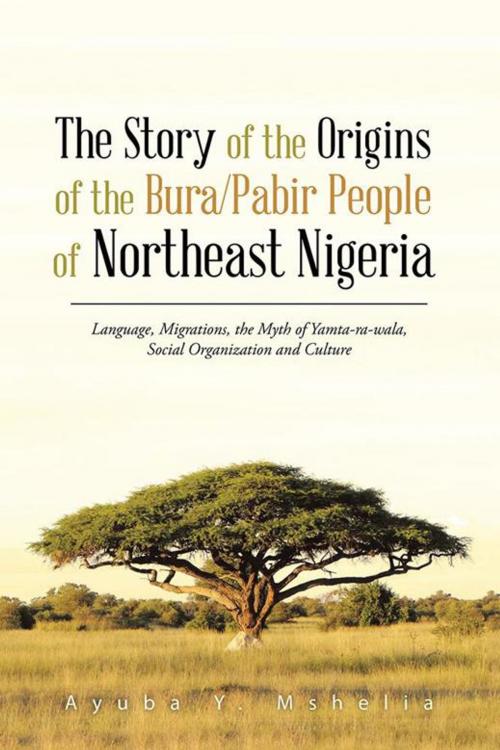The Story of the Origins of the Bura/Pabir People of Northeast Nigeria
Language, Migrations, the Myth of Yamta-Ra-Wala, Social Organization and Culture
Nonfiction, History, Africa, Social & Cultural Studies, Social Science, Cultural Studies, Ethnic Studies| Author: | Ayuba Y. Mshelia | ISBN: | 9781496904287 |
| Publisher: | AuthorHouse | Publication: | May 16, 2014 |
| Imprint: | AuthorHouse | Language: | English |
| Author: | Ayuba Y. Mshelia |
| ISBN: | 9781496904287 |
| Publisher: | AuthorHouse |
| Publication: | May 16, 2014 |
| Imprint: | AuthorHouse |
| Language: | English |
A Synopsis of the Bura Project The three major rationale for writing this book are primarily to: through the study of African language family groups trace the origin of the tribe to a more specific location rather than the diffused response of from the East; secondly to investigate why and how the word Pabir/Babur came on the scene referring to a separate ethnic group different or the same as the Bura and thirdly to document some of the vanishing Bura cultural practices and deeds. For example what their beliefs are, their marriage practices, local industries and what they do to pass time. It is my strong belief that the first objective is accomplished through our analysis and presentation of the Proto-Afro-asiatic linguistic family classification group and its subgroup the Proto-Chadic of which the Biu-Mandara forms a sub-branch. Through a systemic and vigorous study of the classification of the different languages comprising this Proto Family of languages and its sub-branches we are able to assert that the Bura people were among many other ethnic groups part of a group whose origin can be traced to the Levant region of south west Asia and the Middle-East. They belong to the group that forms back to Africa migration. This is because modern genetic studies of languages indicate that theyre the only group that have traces of Y chromosome belonging to haplogroup R1b R-V88 in Africa but found mainly in Asia and Europe. After tracing the influences of the powerful Kanem (ca. 700-1376) and later Bornu-Kanem (1380-1893) empires around the Lake Chad region as well as the kingdom of Mandara (founded in about 1459, i.e. end of the 15th century), in what is today modern Cameroon on the inhabitants of the region, we conclude a chaotic period of migrations and wars, including trade in slaves. It is through this prism that we notice the emergence of the founder of the Woviri dynasty of Biu. Through his failure to win the Maiship of Bornu, he moved to Mandara and then the Plateau of Biu with some of his followers or relatives. Being a student of History Abdulahi or who later became Yamta-ra-wala attempted to replicate what the Kanembu were able to do among the local people they conquered some centuries earlier; they created an ethnicity and language called Kanuri. Yamta-ra-wala succeeded somewhat, but wasnt able to completely conquer the Bura people and turn them in his new ethnic vision. Instead the Buras went to the hills to fight him the next day. The new breed he created he called Pabir or Babur as the Hausa would call them. The myth of who Yamta-ra-wala is has for the present eclipsed historians and would probably continue for some time to come. As for the Bura (Most have down the hill-tops and mountains!) and the Pabir they have never been closer than today. Today for all practical purposes they are one and the same ethnic group, theyve intermingled more than any two previously separated groups. Their vocabulary, phonology and cultural practices have fused into one in most instances.
A Synopsis of the Bura Project The three major rationale for writing this book are primarily to: through the study of African language family groups trace the origin of the tribe to a more specific location rather than the diffused response of from the East; secondly to investigate why and how the word Pabir/Babur came on the scene referring to a separate ethnic group different or the same as the Bura and thirdly to document some of the vanishing Bura cultural practices and deeds. For example what their beliefs are, their marriage practices, local industries and what they do to pass time. It is my strong belief that the first objective is accomplished through our analysis and presentation of the Proto-Afro-asiatic linguistic family classification group and its subgroup the Proto-Chadic of which the Biu-Mandara forms a sub-branch. Through a systemic and vigorous study of the classification of the different languages comprising this Proto Family of languages and its sub-branches we are able to assert that the Bura people were among many other ethnic groups part of a group whose origin can be traced to the Levant region of south west Asia and the Middle-East. They belong to the group that forms back to Africa migration. This is because modern genetic studies of languages indicate that theyre the only group that have traces of Y chromosome belonging to haplogroup R1b R-V88 in Africa but found mainly in Asia and Europe. After tracing the influences of the powerful Kanem (ca. 700-1376) and later Bornu-Kanem (1380-1893) empires around the Lake Chad region as well as the kingdom of Mandara (founded in about 1459, i.e. end of the 15th century), in what is today modern Cameroon on the inhabitants of the region, we conclude a chaotic period of migrations and wars, including trade in slaves. It is through this prism that we notice the emergence of the founder of the Woviri dynasty of Biu. Through his failure to win the Maiship of Bornu, he moved to Mandara and then the Plateau of Biu with some of his followers or relatives. Being a student of History Abdulahi or who later became Yamta-ra-wala attempted to replicate what the Kanembu were able to do among the local people they conquered some centuries earlier; they created an ethnicity and language called Kanuri. Yamta-ra-wala succeeded somewhat, but wasnt able to completely conquer the Bura people and turn them in his new ethnic vision. Instead the Buras went to the hills to fight him the next day. The new breed he created he called Pabir or Babur as the Hausa would call them. The myth of who Yamta-ra-wala is has for the present eclipsed historians and would probably continue for some time to come. As for the Bura (Most have down the hill-tops and mountains!) and the Pabir they have never been closer than today. Today for all practical purposes they are one and the same ethnic group, theyve intermingled more than any two previously separated groups. Their vocabulary, phonology and cultural practices have fused into one in most instances.















